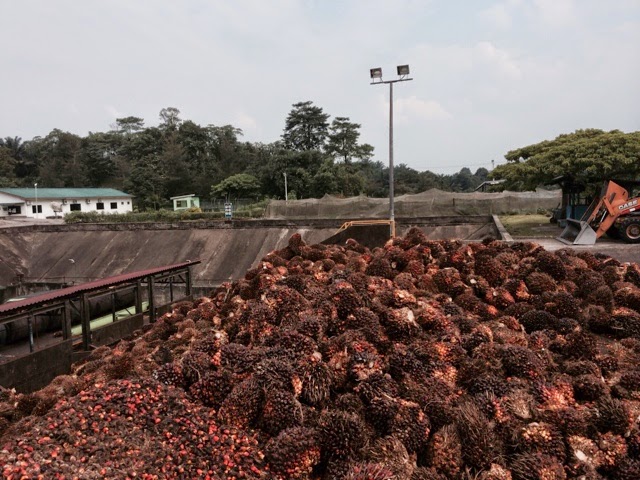
Photographer: Goh Seng Chong/Bloomberg
Workers inspect the quality of harvested oil palm fruit outside a processing mill in Batu Pahat, Johor, Malaysia. Palm oil, used in food and biofuels slumped to a five-year low this month as output from Indonesia and Malaysia outpaced demand amid a glut in global cooking oil supplies, including soybean oil.
Palm Oil Seen Dropping as Mistry Has Buy Call on Planters
By Swansy Afonso
September 16, 2014 5:23 AM EDT
Palm oil’s slump to a five-year low offers investors an opportunity to buy plantation stocks, according to Dorab Mistry, director at Godrej International Ltd., who says producers are still making money.
“I am often asked these days if palm plantation and processing company equities should be bought: my answer is a resounding yes,” Mistry said yesterday, without identifying stocks. “You invest in plantations when palm oil prices are low. I prefer processing companies which manufacture speciality fats, oleochemicals, biodiesel and own consumer brands. Upstream companies will benefit when the price cycle turns.”
Mistry, who’s traded palm oil for more than three decades, joins Standard Chartered Plc in recommending investors buy plantation stocks to profit from a rebound in prices. The oil fell to a five-year low on Sept. 2 as output from Indonesia and Malaysia, the biggest producers, topped demand amid a glut in global cooking oil supplies, including soybean oil. Global palm consumption increased 81 percent in the decade to last year as rising incomes lifted demand, U.S. government data show.
“Long-term demand for palm oil is very supportive of the sector, and that supports the case for recovery in CPO prices,” said Alex Fergusson, a fund manager at Singapore-based Woodside Holdings Investment Management Pte, referring to a period of five to 10 years. Growth in per-capita gross domestic product and populations in emerging markets are the drivers for demand, said Fergusson, who invests in palm plantations.
Price Outlook
Prices will drop in the next few weeks toward the cost at which growers in Asia produce the world’s most-used cooking oil, said Mistry, according to remarks at a conference in Shanghai. Futures will drop to about 1,900 ringgit ($588) a metric ton, he said. That’s 9.6 percent below yesterday’s close on the Bursa Malaysia Derivatives and would be the lowest price since March 2009. The exchange is closed today for a public holiday.
“It is almost impossible to forecast a bottom at this stage of theproduction cycle,” Mistry said. “However, producers are still very much in the money and I do not foresee prices going below cost of production.”
Mistry’s address echoed comments that he made in e-mailed remarks to Bloomberg News last month, when he said the “world is awash with vegetable oils,” and forecast that palm oil would drop toward the cost of output.
Declining Stocks
Palm oil’s drop hurt shares in growers. In Singapore, Golden-Agri Resources Ltd. (GGR) lost 8.3 percent this year to 50 Singapore cents, while Wilmar International Ltd. retreated 8.8 percent to S$3.12. In Malaysia, Kuala Lumpur Kepong Bhd. (KLK) fell 14 percent in 2014.
“We have long argued that the way to make money in the palm sector is to buy growth operators when prices are low and sentiment is weak,” Standard Chartered analysts Adrian Foulger and Denis Chai said in a report dated Sept. 3. The bank named PT BW Plantation as its top pick, while rating it “outperform” along with Golden-Agri and Indofood Agri Resources Ltd.
Palm oil prices are expected to strengthen in the final quarter on lower production, and there’s a better outlook for 2015 as biodiesel demand may increase, RHB Investment Bank Bhd. said in a Sept. 10 report. The bank said it remains overweight on plantation stocks in Indonesia and Singapore.
Palm dropped 21 percent this year to 2,101 ringgit a ton yesterday. Prices fell to a five-year low of 1,914 ringgit on Sept. 2, then rebounded after Malaysia scrapped an export levy for this month and October. Palm’sdiscount to soybean oil was $90.84 a ton today from last year’s average of about $244.
Higher Production
Full-year output in Malaysia, the second-largest grower, will probably be more than the 19.7 million tons to 19.9 million tons initially estimated, Mistry said. In the first eight months, supply was 12.76 million tons, 991,000 tons more than a year ago, while exports dropped 6.6 percent to 10.99 million tons, he said. Indonesian production is also ahead of expectations, he said.
Stockpiles will continue to rise and peak in December, Mistry said. Reserves in Malaysia jumped 22 percent to 2.05 million tons in August from July, the biggest percentage gain since October 2009, Malaysian Palm Oil Board data show.
“In the fourth quarter of 2008, we were facing a similar situation with regard to supply, demand and price,” Mistry said. “At that time, palm rapidly made itself competitive and exported its way out of a crisis as Malaysian stocks peaked at 2.238 million in December 2008.”
Imports of vegetable oils by India, the biggest palm oil buyer, surged to 1.34 million tons in August and may exceed 1 million tons this month, Mistry said. Many vessels carrying palm oil to China were diverted to India in August, and berths there are now congested, he said. Chinese imports will probably remain thin for at least the next three months, he said.
To contact the reporter on this story: Swansy Afonso in Mumbai atsafonso2@bloomberg.net












